 PADI Tec Rec Centre Cyprus – Technical Diving Instruction
PADI Tec Rec Centre Cyprus – Technical Diving Instruction
Deep and Rebreather Diving Cyprus
DSAT/PADI TEC REC COURSES CONDUCTED WITH A PADI TEC REC CENTREÂ
Tec Rec Courses Evolution
Only PADI TecRec courses Cyprus conducted through a Padi Tec Rec Centre Cyprus have been revised tweaked and reconfigured. TecRec is now made up of 5 diver certifying levels – Tec 40, Tec 45, Tec 50, Tec Trimix 65 and Tec Trimix Diver. These NEW changes, which mainly affect the Tec Deep Diver course providing a series of more compact steps of progression, with the diver acquiring new skills and capabilities at each stage. The Dive Tec Rec Courses and Padi Course Director can now offer all these courses up to Instructor levels.
The new tec rec course levels reflect the depth to which the diver can reach on the course: Tec 40, Tec 45, Tec 50 and Tec Trimix 65. Each of the first 3 levels of the Tec Rec Diver courses require four dives/water sessions and the Tec Trimix 65 requires five dives/water sessions. The Tec Trimix Diver course remains unchanged.
When one tank is not enough (Go Tec) … When two tanks is not enough (Go Tec Deep) … When three tanks is not enough … (Go Trimix) … When you love Tec Diving too much Go TecRec Instructor with Easy Divers Cyprus…
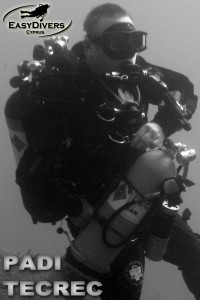
Technical Diving
Technical diving in Cyprus is scuba diving’s “extreme†sport, taking experienced and qualified divers far deeper than in
mainstream recreational diving. Technical diving TEK is marked by significantly more equipment and training requirements to manage the additional hazard this type of diving entails. Tec diving isn’t for everyone, but for those who hear its challenge call, the PADI TecRec courses are the answer.
What is technical diving?
Technical scuba diving is defined as diving other than conventional commercial or research diving that takes divers beyond recreational scuba diving limits. It is further defined as and includes one or more of the following:
- diving beyond 40 metres/130 feet deep
- required stage decompression
- diving in an overhead environment beyond 40 linear metres/130 linear feet of the surface
- accelerated decompression and or the use of variable gas mixtures during the dive
Because in technical diving the surface is effectively inaccessible in an emergency, tec divers use extensive methodologies and technologies and training to manage the added risks. Even with these, however, tec diving admittedly has more risk, potential hazard and shorter critical error chains than does recreational scuba diving.
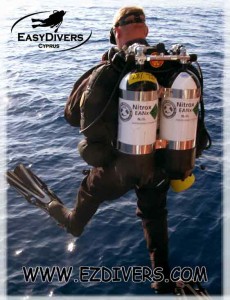
How long has technical diving been around?
Padi tec rec cyprus, has been round foryears and most people would agree that cave diving is a form of technical diving. Cave diving developed in the late 1960s and 1970s, developing into a discipline largely like it is today by the mid 1980s. In the early 1990s, several groups of divers around the world began experimenting with technologies for deep diving (beyond recreational limits) to explore both caves and wrecks. These communities united and emerged as “technical diving†or “tec diving†with the publication of aquaCorps (no longer in print), which dedicated itself to this type of diving. Since then, TEK diving continues to develop both in scope and in its technologies.
Why would I want to be a tec diver?
Tech diving not only has more risk, but it requires significantly more effort, discipline and equipment. It’s not for everyone, and you can be an accomplished, avid top-notch diver your entire life without making a tec dive.
That said, there’s a cadre of individuals who want to visit places underwater that relatively few people can. Many spectacular, untouched wrecks lie at depths well below 40 metres/130 feet. Deep reefs have organisms you don’t find in the shallows. Some people enjoy the challenge and focus tec diving requires. Still others love being involved with cutting edge technologies. These reasons make tec diving rewarding.
The PADI TecRec Difference
The TecRec program debuted in 2000. Although TecRec is not the first tek diving program (cave diver training has been around for decades), it repeatedly receives accolades for its merits.
- TecRec courses are integrated into an instructionally valid, seamless course flow that takes you from beginning tec diver to one qualified to the outer reaches of sport diving using different gas mixes.
- Each level introduces you to new gear, planning and procedures appropriate to extend your diving limits.
- The Tec Diver course is an integrated sequence of three sub-courses: Tec 40, Tec 45 and Tec 50. You can complete them continuously, or you can complete each level separately with a time span between them. This gives you learning efficiency, instructional integrity and schedule flexibility.
- These courses are equivalent to TDI advance nitrox, decompression procedures and extended range.
Prerequisites:
TecRec prerequisites vary (see individual course descriptions), but the following applies to anyone interested in technical diving: You must be
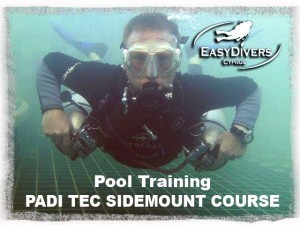 18 years or older
18 years or older- A mature, responsible person who will follow the required procedures and requirements strictly and faithfully
- Medically fit for tec diving (physician’s signature required)
- Willing to accept the added risks that tec diving presents
- An experienced diver with at least 100 logged dives
- Certified as a PADI Enriched Air Diver and PADI Deep Diver or equivalent (for this program equivalence is proof of training in recreational deep diving 18 meters/60 feet to 40 meters/130 feet consisting of at least four dives and training in nitrogen narcosis considerations, contingency/emergency decompression, making safety stops and air supply management OR, have a minimum of 20 logged dives deeper than 30 meters/100 feet.)
PADI TecRec Qualifying Diver Level Certifications from other Organisations
Click Here!
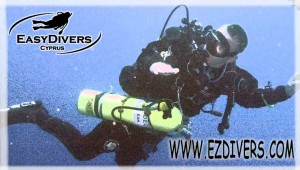
The Fun Part
The fun part of TecRec Cyprus is rising to the challenges as you dive deeper and longer than most divers ever do.
Tec Rec Courses – DSAT Diver Levels
Most of the names of the courses in TecRec range include a number (eg Tec 40). This is an indication of the maximum depth in metres intended for a diver certified at this level. As a general rule, each course includes four dives.
Padi TEC REC Diver Training Courses in Cyprus
Discover Tec Cyprus
This short session allows divers to give technical diving a try. It does not result in a certification, but lets a diver experience wearing the extra gear involved in technical diving and understand the rationale behind it.
Tec 40
The entry point into the technical range, Tec 40 provides a transition from recreational to technical diving. Although the use of full tech gear (doubles and wings) is preferred, it does allow modified use of recreational gear in some situations, provided the diver has two separate regulators, with one of the first stages fitted with a long hose. (For example, a main cylinder and pony cylinder combination). The intended working limit for a diver at this level is 40 metres/130 feet with up to 10 minutes of non-accelerated decompression. They may use any EANx mix with up to 50% oxygen content or air. To enrol on the course, a diver must be the equivalent of a PADI Advanced Open Water diver, with an EANx Diver rating and have deep recreational diving experience.
Tec 45
The diver must use full ‘standardised’ tech rig, including wings and doubles plus an additional deco cylinder (note that side mounted cylinders are an acceptable alternative to back mounted doubles throughout the TecRec range). The course allows the diver to go to 45 metres/145 feet and make accelerated decompression dives using any mix of EANx or pure oxygen. A diver must have the equivalent of a Tec 40 rating to enrol on this course.
Tec 50
This course represents a high level of competency for a technical diver. Although the option exists to make the last dive of the course using trimix, it is intended as an air/nitrox rating and by the end the diver can dive to a maximum of 50 metres/165 feet and make extended, accelerated decompression dives.
Tec Trimix 65
This course opens up the advantages of trimix to the diver, and divers are qualified to make multi-stop decompression dives that employ EANx and oxygen for accelerated decompression, using any trimix with an oxygen content of 18% or more. They can dive to a maximum depth of 65 metres/210 feet.
Tec Trimix
This course lets the diver go deeper, opening up the option of using travel gases and trimix with less than 18% oxygen content. Dives made during the course can be as deep as 90 metres/300 feet. Once qualified, the diver can start to explore deeper; for this reason there is no numbered suffix after the course title as in the rest of the range — there are no limits placed on how deep the diver can go after training, providing they build their experience gradually.
Speciality TecRec Courses
Some TecRec instructors have been authorised by PADI to offer distinctive speciality courses in technical diving. These tend to be offered in areas where the diving environment demands specialist training. Examples include Cave Diver, Advanced Wreck Diver and Technical Rescue Diver.
Instructor Levels
Tec Instructor
Technical diving cyprus. and the Tec Instructor is able to teach the Tec 40 course. Prerequisites for an instructor to attain this rating include being a Tec 45 diver or similar, being a PADI MSDT, EANx instructor and Deep Diver Instructor.
Tec Deep Instructor
Tec Deep Instructors can offer the Tec 40, Tec 45 and Tec 50 courses.
Tec Trimix Instructor
Instructors at this level can offer any of the diver level courses in the TecRec range.
Gas Blender – Instructor
The Gas Blender rating certifies the holder to mix enriched air or trimix for divers to use in recreational or technical diving operations. Courses for this level are conducted by Gas Blender Instructors.
Technical Diving Division (TDD)
PADI has deliberately kept technical diver training separate from mainstream diver training by providing such training under the TecRec name. The TecRec courses have become known as benchmarks of quality in the tech diving world, with a rigorous, yet easy to follow training scheme well supported by PADI-style training materials. Within the PADI organisation, selected staff members are designated as members of the Technical Diving Division, and have the necessary experience to provide TecRec instructors with any back up and support they need to conduct these courses.
The principle officers of the TDD are:
President: Drew Richardson
Vice President, Rebreather Technologies: Mark Caney
Director, Market Development: Terry Cummings
Director, Advanced Wreck Diving: James Morgan
Director, Cave Diving: Steve Mortell
Director, Decompression Diving: Karl Shreeves
In each PADI office, there are individuals designated as TDD Technical Consultantswho are experienced technical instructors. They can provide advice to existing TecRec instructors or advise you if you don’t have a TecRec rating yet but are thinking of getting one.
TecRec TMX 45 and TMX 50 Distinctive Specialties
Posted in Decompression, Training with tags Trimix Specialty on October 12, 2010 by TekScep
PADI Technical Consultants have written a TecRec Distinctive Specialty to introduce the use of trimix when diving shallower than 50m/165 feet.
The primary reason for using trimix at these depths is to reduce narcosis. Whilst many divers are happy to dive on EANx or air to 50m/165 feet, others are not. In challenging diving conditions reducing narcosis can be desirable to almost all divers.
This is an optional course which can be taught to PADI Tec 45 and Tec 50 qualified divers to enable them to use trimix with a minimum of 21% Oxygen and a maximum of 20% Helium to make dives within their current TecRec certification depth limit with a planned decompression not exceeding 20 minutes.
The course utilises existing PADI course materials and content to introduce divers to trimix use within the limits described above. Students complete some self-study, a short knowledge development session, practical application and two dives using trimix.
The pre-requisite to teach these courses is to be an existing PADI Tec Trimix Instructor. The Instructor Distinctive Specialty application fee includes the course outline and a PowerPoint presentation. Suitably qualified instructors will then become PADI TMX 50 Instructors and will be able to teach both TMX 45 and TMX 50 diver level courses.
Open-Circuit Scuba
Scuba stands for self-contained, underwater breathing apparatus. It means that scuba divers carry all of the breathing medium they need with them for the duration they are underwater. Open-Circuit scuba is different than Closed-Circuit scuba and Semi-Closed Circuit scuba.
In Closed-Circuit scuba there is a total recirculation of the gas supplied to the diver. In Semi-Closed Circuit scuba, some of the gas is reused by the diver. In contrast, the gas supplied during Open-Circuit scuba is not recycled at all. When a diver breathes out, the exhalation goes out to the surrounding water instead of being recirculated somehow.
In Closed-Circuit scuba, oxygen and mixed gas are used as the gas supply for the diver. In Semi-Closed Circuit scuba, mixed gas is used as the gas supply. In contrast, Open-Circuit scuba uses mixed gas and air as the gas supplies, with air being the main gas supply for Open-Circuit scuba divers.
Rebreathers – what are they and why would I want to dive one?
Posted in Rebreathers with tags Rebreathers on November 25, 2010 by TekScep
By Vikki Batten, PADI Technical Consultant
With the recent announcement that PADI will introduce a new range of rebreather courses from next year this is a good time to find out a bit more about them if you are not already familiar with them.
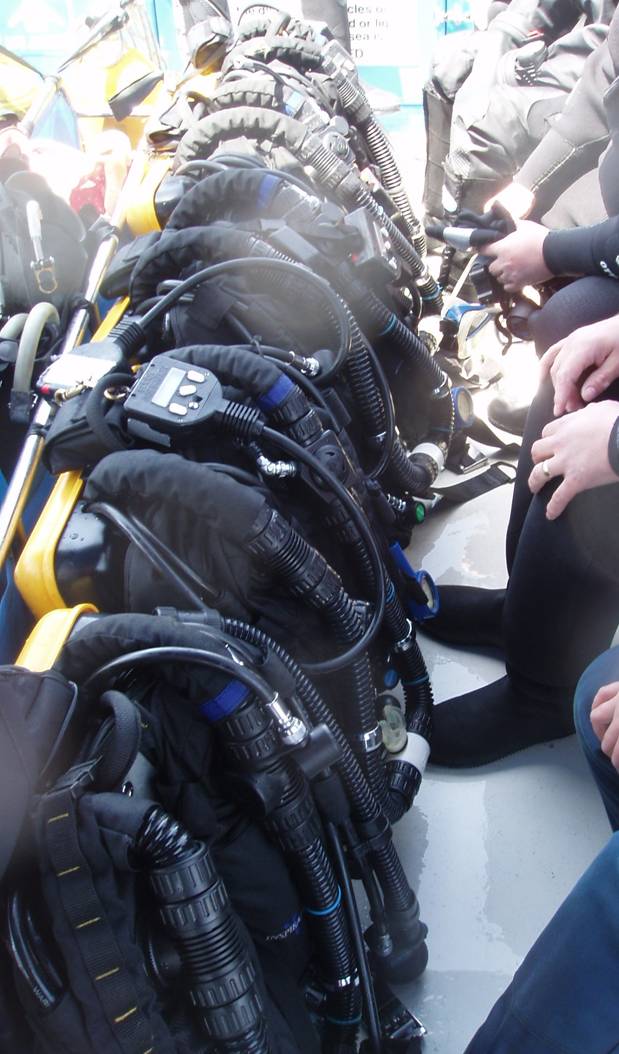 Rebreathers are not new technology. In fact, they have been around for longer than open circuit SCUBA but recent improvements in materials, engineering, monitoring systems and electronics have made them increasingly reliable and priced within reach of the majority of divers.
Rebreathers are not new technology. In fact, they have been around for longer than open circuit SCUBA but recent improvements in materials, engineering, monitoring systems and electronics have made them increasingly reliable and priced within reach of the majority of divers.
The basic concept of a rebreather is to recirculate the divers exhaust gas (or rebreathe it) thereby saving it instead of exhaling it into the water. This makes the gas supply last longer and that is something all divers can enjoy the benefits of.
When we breathe a gas we use oxygen up as part of the metabolic process and we produce carbon dioxide as a waste product. This means that the gas we exhale is high in CO2 and low in O2. This is the gas that we recirculate in our rebreathers so it needs a bit of “tweaking†before we breathe it again. Rebreathers contain a “scrubber†which removes the carbon dioxide. The scrubber will only do this for a certain amount of time (typically at least 2 hours) so this becomes a potentially limiting factor when planning a rebreather dive. The rebreather will also have a mechanism for replacing the oxygen that was metabolised with fresh nitrox or oxygen. The gas supply will also be a limiting factor but compared to normal “open circuit† SCUBA it will usually last much longer.
SCUBA it will usually last much longer.
And that’s it! Well, sort of…..these days electronics monitor and often control the system meaning that the diver has some assistance in ensuring that the rebreather continues to work correctly. Rebreathers have different levels of sophistication but many can now be run almost on auto-pilot with the diver just keeping an eye out for alerts and warnings.
These relatively recent developments have led PADI to consider that now is the time to develop a full range of rebreather courses to introduce our divers to this technology.
So how does this benefit the diver? As we have already mentioned, recirculating the gas means that it lasts much longer than open circuit scuba. This is the main benefit to recreational divers. How long depends on lots of things including the type of rebreather you dive. A longer duration for the same amount of gas means that you can either carry a smaller set of kit for the same duration dive or choose a rebreather that will allow you to do longer dives.
Some rebreathers act like a mobile gas mixing unit altering the amount of oxygen and inert gases the diver breathes with their depth so that the diver is always breathing the optimal mix. This means longer no decompression limits for recreational divers or less decompression for technical divers.
Whilst these are the biggest benefits there are a couple of others:
Less Bubbles makes rebreathers popular with photographers. It makes you a much quieter diver which in turn can minimise your impact on wildlife and lead to close encounters with even very shy creatures. You will hear the sounds of the underwater world and might even hear your buddy singing to themselves J
 Warmer breath. Because your exhaled breath is recycled it is warm and moist helping to avoid heat and moisture loss.
Warmer breath. Because your exhaled breath is recycled it is warm and moist helping to avoid heat and moisture loss.
Of course, there is a price to pay for all these benefits. Quite literally in fact – the equipment is currently more expensive than a basic set of single cylinder dive kit but manufacturers are working hard to make rebreathers value for money and many divers spend just as much on open circuit equipment as the cost of a rebreather. You will also need to factor in the training costs. Although rebreathers aimed at recreational divers are easy to use there are some differences in procedures than you learned on your Open Water Diver course. Good training will mean that you can dive a rebreather with full confidence in both the unit and your ability to dive it.
Which brings us on to safety. Over the years rebreather accidents have been given disproportionate column space but you’re right to make sure this is a technology that you are comfortable using. Rebreather diving is less forgiving of divers who like to cut corners or ignore rules so if you are that type of diver this is not the equipment for you! If you are happy to put the time and effort into preparing your equipment carefully, checking it thoroughly and taking responsibility for monitoring it throughout the dives then the right training will make you a rebreather diver, not only in name but in method and mentality as well.
Remember that diving equipment is a tool for a job so the final step is to ask whether a rebreather is the best equipment for the type of diving you want to do and where you want to do it. If the answer is NO then you should be looking at other options, if the answer is YES then it’s time to write a very nice letter to Father Christmas….
PADI Rebreather Courses
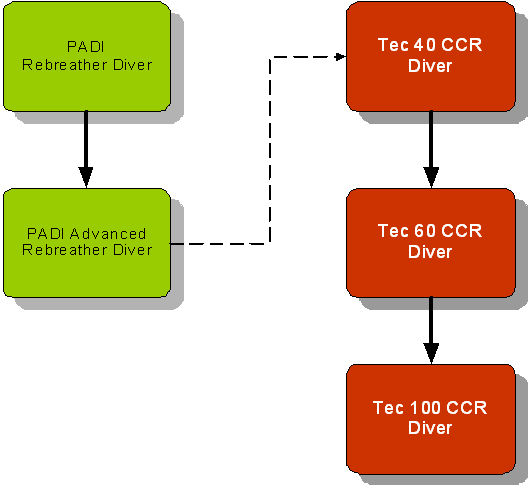 At the recent Eurotek conference in the UK, PADI released more information about its plans with rebreathers.
At the recent Eurotek conference in the UK, PADI released more information about its plans with rebreathers.
Mark Caney, Vice President, Rebreather Technologies in the PADI Technical Diving Division gave a presentation on the coming range of courses. The courses will be introduced at some time during 2011 and consist of both recreational courses under the PADI name, and a range of technical courses which will form part of the TecRec range.
Caney emphasised that courses were still in development, and so subject to change, however indicated the likely layout of the courses would be as below.
Although some credit will be given for anyone who has completed the recreational courses before entering the technical range, there is no requirement for them to do so, as PADI is treating the two styles of diving quite differently.
When asked which units would be approved for these courses, Caney explained that PADI would be designating two categories of rebreather; a Type R for recreational diving, and a Type T for technical diving.

A Type R unit will have a high level of automation but relatively limited diver controls. (The Poseidon MkVIÂ Discovery was mentioned as the only unit in production at present meeting these requirements).
A Type T will have a wider range of controls for the user but will require significantly more discipline and training on the part of the diver in order to use them in the technical diving envelope. (Most of the current production units could meet the Type T requirements; however, PADI is considering requiring some form of third party testing of rebreather designs prior to approval as this technology is so new and relatively complex).
Mark Caney suggested that if any instructors are planning to take advantage of these new courses that they should start to gain experience with rebreathers, as PADI will be expecting new instructors to show that they have acquired a significant amount of experience diving a given rebreather before they can teach others how to use it.
Discovery MkVI
The Discovery Rebreather

The Poseidon Discovery is the world’s first rebreather for recreational divers. It’s a fully-closed, fully-automated unit that will make you see diving in a different light.
The system comprises a breathing loop (mouthpiece, hoses, counter lungs and backpack) with associated electronics module, and two independent gas cylinders. One contains 100% compressed oxygen which is added to the breathing loop as the diver consumes it. The second cylinder typically contains compressed air “diluent” to compensate for compression in the breathing loop as the diver goes deeper. It’s also a back-up system, containing enough oxygen for the diver to breathe directly in an emergency.
The dive is fully managed by onboard computers, with two continuously recalibrating sensors constantly monitoring oxygen levels, and dive information recorded in the removable battery module. The hand-held control unit displays depth, cylinder pressure, and oxygen concentration. The system is also equipped with a number of active warning systems.
To begin the dive, the diver must ensure that the battery is charged, the bottles are filled with gas and the pre-packaged scrubber is attached. The computer then performs a thorough pre-dive test to ensure that all parts of the system are functioning properly before the dive is allowed to proceed.
Light, safe and simple to use, the Discovery is designed not only for seasoned divers, but for those who are new to the experience. With so much less to do, you’re free to concentrate on the dive itself. And with no bubbles to frighten the sea life, it’s a dive you’ll enjoy more than ever. It’s also a dive you can enjoy for longer, with the potential to stay under water for up to three hours at a maximum depth of 40 m.
At just 18 kilos (39.6 lbs) fully gassed up and ready to dive, the Discovery MkVI weighs less than many dive tanks weigh on their own. And minus tanks and canister, it weighs just 8 kilos (17.6 lbs), making it easy to travel with.
Note: The Discovery MkVI is never delivered direct to individual purchasers. It can only be sold to divers certified to use it, and delivery is always to an authorized dealer.
SHOULD YOU WISH TO GET CERTIFIED?
Contact our Padi Tec Rec Centre Cyprus  speak to our Technical Course Director for TecRec
